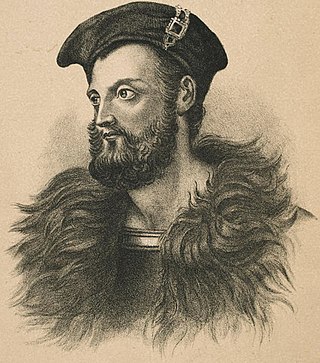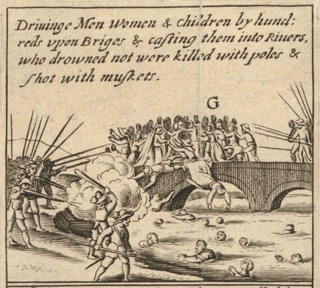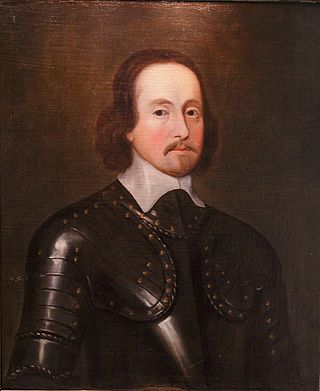

The Laggan Army, sometimes referred to as the Lagan Army, was a militia formed by Protestant settlers in the fertile Laggan district in the east of County Donegal in Ulster, during the time of the Irish Rebellion of 1641.


The Laggan Army, sometimes referred to as the Lagan Army, was a militia formed by Protestant settlers in the fertile Laggan district in the east of County Donegal in Ulster, during the time of the Irish Rebellion of 1641.
Following the defeat of Gaelic Ireland after the Nine Years War and the Flight of the Earls in 1607, the colonization of Ulster began in 1609. English and Scottish settlers, supported by the Crown, started to colonize the north-east province of Ulster. The settlers largely settled on land which was confiscated from Gaelic chiefs in Ulster, many of whom had fled from Ireland following the Irish defeat in the Nine Years' War. [1]
In 1641, the Irish rose up in a rebellion led by Felim O'Neill. This coup's purposes included putting an end to anti-Catholic discrimination, greater Irish self-governance, and to partially or fully reverse the plantations of Ireland. Although it was intended to be bloodless, the rebellion was characterized by rebel atrocities against Protestant settlers. While O'Neill himself was opposed to these attacks he was unable to control the Irish rebels under his command. [2] [3]
At the outset of the rebellion, thousands of Protestant settlers were evicted from their lands. Their homes were burned and their possessions taken. Most attacks involved robberies and assaults, however if the settlers resisted they were often murdered by the Irish rebels. Thousands of the Protestant refugees sought safety and protection in Royalist strongholds or attempted to leave Ireland and return to England and Scotland. [4] [5]
Protestant militias along with English and Scottish soldiers replied with brutal reprisals. Often after rebels surrendered, they were given no quarter. Reports of the violence against the Protestants were widely exaggerated in press reports in Britain. Initially, Parliamentarian propaganda pamphlets claimed over 200,000 Protestants were killed, which was widely believed despite the fact that the estimates being stated were almost twice the number of Protestants living in Ireland at the time. On 3 April 1642, a Scottish Covenanter expeditionary army landed in Ulster to protect the Planter population. Prior to that Protestants had to defend themselves by means of militias such as the Laggan Army. Afterwards the Laggan Army continued to operate in Ulster, and often participated in joint campaigns with the Scottish expeditionary force. [6]
Eventually, violence against civilians by both sides began to calm, mainly due to the arrival of Eoghan Ruadh O'Néill, an experienced Irish general who had served under the Spanish in Flanders in the Eighty Years' War. He landed in Ireland in 1642 along with several other Gaelic Irish and Old English officers, an example of the latter being Thomas Preston. Due to their experience they were given positions of command within the Confederate military. O'Neill began disciplining the troops of the Irish Ulster Army and hanged soldiers who attacked civilians. In turn, reprisals by Protestants also declined. [7]
Wealthy Protestant landowners in northwest Ulster such as Sir William Cole, Sir William Stewart and his brother Sir Robert Stewart chose to defend their properties by organizing militias. [4] The Stewarts were Scottish settlers who had served King Charles I of England in the military. During the colonization of Ulster, King Charles awarded English and Scottish loyalists such as the Stewarts with large tracts of escheated land under the condition that improvements be made and tenant settlers be brought over from England or Scotland. [8] [9]
The Stewarts were held in such high regard by the Crown that immediately after the outbreak of the rebellion, King Charles authorized both of the Stewarts to establish a regiment of 1,000 foot and a troop of horse for the king's service. The military force that the Stewarts created came to be known as the Laggan Army. Originally the unit was formed to protect the Laggan Valley in eastern Donegal along with the northwest portions of counties Tyrone and Derry. [10] As the war progressed, the Laggan Army became the most dominant Royalist militia in Ulster, defending and relieving Protestant strongholds; escorting refugees to safe havens; conducting reprisal attacks on the Irish rebels; and supporting other Royalist militias in numerous conflicts. [11] [12]
William Stewart served as the nominal leader of the Laggan Army in the beginning as he had greater seniority and landed interests than his brother. Fairly quickly, however, Robert Stewart was selected for overall command based upon his extensive experience in the Thirty Years' War on the European continent. [11] [13] Robert Stewart was resourceful and proved to be adept at recruiting men and training military units. His troops were better equipped than the rebels they faced especially with respect to muskets. And perhaps most important of all, Stewart was both experienced and knowledgeable with regard to battlefield tactics. [11]
On 16 June 1642, the Laggan Army confronted and defeated a large Confederate Irish force commanded by Phelim O'Neill at the battle of Glenmaquin, near Raphoe. The Confederates were invading County Donegal intent upon bringing northwestern Ulster and the Royalist stronghold and port city of Derry under their control, however the Laggan Army routed them and then went on to capture a number of towns in Ulster ending the Confederate threat in the region for the time. [4] [14]
The Laggan Army continued to serve in King Charles' service during the time of the First English Civil War and the Eleven Years' War. On 13 June 1643, Robert Stewart and the Laggan defeated General Owen O'Neill and the Confederates at the Battle of Clones and on 8 July 1645 the Laggan Army assisted Sir Charles Coote and the Parliamentarians capture Sligo. [15] [16]
In 1646, the Laggan Army was one of three forces including Scottish Covenanter regiments and English settler armies commanded by Robert Monro that was to be included in an attack on Owen Roe O'Neill and the Confederates in Ulster. The Laggan Army was in Clogher on its way to meet up with Monro's force on 4 June when Monro's Scottish Covenanter and settler militia force was confronted and decisively defeated by Irish general Owen Roe O'Neill at the Battle of Benburb. After the battle, the Laggan Army retreated back to Derry and Enniskillen to prepare for a potential attack when the Confederates travelled west to Clones. [17] [18]
After the failed siege of Derry in 1649, the Laggan Army started to break apart. Factions transferred their allegiance to the side of the Parliamentarians and eventually fought against their compatriots at the battles of Lisnagarvey, Scarrifholis, and Charlemont. [19] By the end of 1649, the Laggan Army had ceased to be effective as a fighting force due to internal ethnic divisions and as a result the force disbanded. [20]

Owen Roe O'Neill was a Gaelic Irish soldier and one of the most famous of the O'Neill dynasty of Ulster. O'Neill left Ireland at a young age and spent most of his life as a mercenary in the Spanish Army serving against the Dutch in Flanders during the Eighty Years' War. After the Irish Rebellion of 1641, O'Neill returned and took command of the Irish Confederate Ulster Army. He is known for his victory at the Battle of Benburb in 1646.

The Irish Confederate Wars, also called the Eleven Years' War, took place in Ireland between 1641 and 1653. It was the Irish theatre of the Wars of the Three Kingdoms, a series of civil wars in the kingdoms of Ireland, England and Scotland – all ruled by Charles I. The conflict had political, religious and ethnic aspects and was fought over governance, land ownership, religious freedom and religious discrimination. The main issues were whether Irish Catholics or British Protestants held most political power and owned most of the land, and whether Ireland would be a self-governing kingdom under Charles I or subordinate to the parliament in England. It was the most destructive conflict in Irish history and caused 200,000–600,000 deaths from fighting as well as war-related famine and disease.

The Plantation of Ulster was the organised colonisation (plantation) of Ulster – a province of Ireland – by people from Great Britain during the reign of King James I. Most of the settlers came from southern Scotland and northern England; their culture differed from that of the native Irish. Small privately funded plantations by wealthy landowners began in 1606, while the official plantation began in 1609. Most of the colonised land had been confiscated from the native Gaelic chiefs, several of whom had fled Ireland for mainland Europe in 1607 following the Nine Years' War against English rule. The official plantation comprised an estimated half a million acres (2,000 km2) of arable land in counties Armagh, Cavan, Fermanagh, Tyrone, Donegal, and Londonderry. Land in counties Antrim, Down, and Monaghan was privately colonised with the king's support.

Sir Phelim Roe O'Neill of Kinard was an Irish politician and soldier who started the Irish rebellion in Ulster on 23 October 1641. He joined the Irish Catholic Confederation in 1642 and fought in the Wars of the Three Kingdoms under his cousin, Owen Roe O'Neill, in the Confederate Ulster Army. After the Cromwellian conquest of Ireland O’Neill went into hiding but was captured, tried and executed in 1653.

The Irish Rebellion of 1641 was a Catholic-led uprising in Ireland, whose demands included an end to anti-Catholic discrimination, greater Irish self-governance, and return of confiscated Catholic lands. Its timing was partially driven by the dispute between Charles I and his opponents—the English Parliamentarians and Scottish Covenanters—which the rebels feared would lead to an invasion and further anti-Catholic measures. Beginning as an attempted coup d'état by Catholic gentry and military officers, it developed into a widespread rebellion and ethnic conflict with English and Scottish Protestant settlers. It led to the 1641–1652 Irish Confederate Wars, part of the Wars of the Three Kingdoms, with up to 20% of the Irish population becoming casualties.

Confederate Ireland, also referred to as the Irish Catholic Confederation, was a period of Irish Catholic self-government between 1642 and 1652, during the Eleven Years' War. Formed by Catholic aristocrats, landed gentry, clergy and military leaders after the Irish Rebellion of 1641, the Confederates controlled up to two-thirds of Ireland from their base in Kilkenny; hence it is sometimes called the "Confederation of Kilkenny".

The Battle of Benburb took place on 5 June 1646 during the Irish Confederate Wars, the Irish theatre of the Wars of the Three Kingdoms. It was fought between the Irish Confederates under Owen Roe O'Neill, and an army of Scottish Covenanters and Scottish/English settlers under Robert Monro. The battle ended in a decisive victory for the Irish Confederates and ended Scottish hopes of conquering Ireland and imposing their own religious settlement there.


The Battle of Rathmines was fought on 2 August 1649, near the modern Dublin suburb of Rathmines, during the Irish Confederate Wars, an associated conflict of 1638 to 1651 Wars of the Three Kingdoms. It has been described as the 'decisive battle of the Engagement in Ireland.'

Plantations in 16th- and 17th-century Ireland involved the confiscation of Irish-owned land by the English Crown and the colonisation of this land with settlers from Great Britain. The Crown saw the plantations as a means of controlling, anglicising and 'civilising' Gaelic Ireland. The main plantations took place from the 1550s to the 1620s, the biggest of which was the plantation of Ulster. The plantations led to the founding of many towns, massive demographic, cultural and economic changes, changes in land ownership and the landscape, and also to centuries of ethnic and sectarian conflict. They took place before and during the earliest English colonisation of the Americas, and a group known as the West Country Men were involved in both Irish and American colonization.

The O'Doherty family of County Donegal is an Irish clan, who were a prominent sept of the Northern Uí Néill's Cenél Conaill.

Ireland during the period of 1536–1691 saw the first full conquest of the island by England and its colonization with mostly Protestant settlers from Great Britain. This would eventually establish two central themes in future Irish history: subordination of the country to London-based governments and sectarian animosity between Catholics and Protestants. The period saw Irish society outside of the Pale transform from a locally driven, intertribal, clan-based Gaelic structure to a centralised, monarchical, state-governed society, similar to those found elsewhere in Europe. The period is bounded by the dates 1536, when King Henry VIII deposed the FitzGerald dynasty as Lords Deputies of Ireland, and 1691, when the Catholic Jacobites surrendered at Limerick, thus confirming Protestant dominance in Ireland. This is sometimes called the early modern period.

The Portadown massacre took place in November 1641 at Portadown, County Armagh, during the Irish Rebellion of 1641. Irish Catholic rebels, likely under the command of Toole McCann, killed about 100 British Protestant settlers by forcing them off the bridge into the River Bann, and shooting those who tried to swim to safety. The settlers were being marched east from a prison camp at Loughgall. This was the biggest massacre of Protestants during the rebellion, and one of the bloodiest during the Irish Confederate Wars. The Portadown massacre, and others like it, terrified Protestants in Ireland and Great Britain, and were used to justify the Cromwellian conquest of Ireland and later to lobby against Catholic rights.

The Battle of Lisnagarvey was fought on 6 December 1649, near Lisnagarvey during the Irish Confederate Wars, an associated conflict of the 1638 to 1651 Wars of the Three Kingdoms. Forces loyal to the Commonwealth of England defeated an army supporting Charles II of England, composed of Royalists and Scots Covenanters.
Presented below is a chronology of the major events of the Irish Confederate Wars from 1641 to 1653. This conflict is also known as the Eleven Years War. The conflict began with the Irish Rebellion of 1641 and ended with the Cromwellian conquest of Ireland (1649–53).


The Second Ormonde Peace was a peace treaty and alliance signed on 17 January 1649 between the Marquess of Ormonde, the leader of the Irish Royalists, and the Irish Confederates. It united a coalition of former Protestants and Catholics enemies from Ireland, Scotland and England - the three Kingdoms ruled by Charles I who was then held a prisoner by the Puritan London Parliament. His execution on 30 January drew together the signatories in allegiance to his young son Charles II.
Colonel Rory Maguire was an Irish politician and soldier. He was a leading instigator of the Irish Rebellion of 1641 and subsequently participated in the Irish Confederate Wars as a senior Confederate commander.